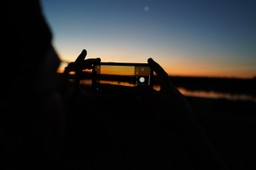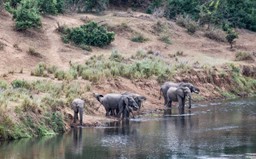The dry season offers something particularly beautiful, with its warm colours, dry trees and deep-blue cloudless skies. It encompasses nature from a different perspective. In this dry landscape, with minimum greenery, life is visible. This season offers a time where animal movement is much more active and visible, and cooler days makes wildlife – especially bird sightings – exceptional.
As water sources begin to dry up, animals are drawn to the remaining waterholes and rivers to drink, usually early mornings and evenings. Luckily for us there are watering holes right in front of our lodge, so you’re almost guaranteed sightings while having breakfast or lying at the pool.
Temperatures are at their most pleasant, with warm days, low humidity, and virtually no rainfall. Mid-day temperatures average a very pleasant 25°C, while the nights can drop to 10 degrees or less – so be sure to pack those warm clothes because the evenings are chilly – especially for early morning bush walks and evening game drives (we’ll provide your with blankets in your safari vehicle).
Although malaria-carrying mosquitoes are far more rare in the winter months, we still recommend sunscreen and insect repellent.
In general the cold and dry winter months are difficult times for mammals. They concentrate their rhythms to move closer to permanent water resources, such as perennial rivers and streams and artificial water points. Carnivores survive much better during these months, as they are able to focus their movement closer to these resources and adapt their hunting patterns according to their prey’s water needs and restrictions. Certain predators, including leopards and lions which normally hunt at night, adapt their patterns to hunt when their prey are at the watering hole during the day. This is a perfect opportunity for guests to witness one of nature’s more action-packed sightings!
Smaller animals such as birds, insects, rodents and reptiles have to plan their routines well in order to survive the colder months, with their shorter days. Due to their small body mass and therefore faster metabolism they tend to lose fitness quickly. The common dwarf mongoose that sleeps in the tunnels of termite heaps must first warm up in the sun before they start scrambling for their invertebrate prey, which also only become active later in the day.
Some animals go to much greater lengths in search of good quality grazing, even just for a few months. Elephants, zebras, wildebeest and giraffes are examples of succulent species that either follow natural migration routes or can travel very far distances during the cooler months.
In every season, nature reveals sincerity, authenticity and beauty. At the end of the day there is no perfect day, time or season to visit Kruger, because each day brings its own light, sightings and stories.
Experience it for yourself – view our limited time special rates & packages.








